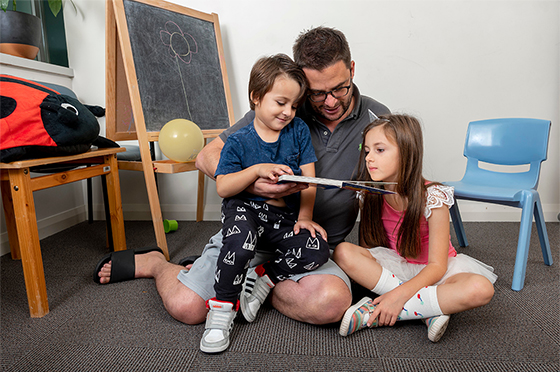 We have all seen the idyllic scenes from movies capturing what we imagine bedtime stories to be like with small children: snuggly PJs on, sitting quietly on Mum or Dad’s lap, studying each page and listening intently to every word of a nice quiet story before bed. Anyone who has spent time reading stories with young children will know that this is not always how it goes! However, even when story time doesn’t go how adults think it should, it can still be a special time for children to share with their parents and caregivers.
We have all seen the idyllic scenes from movies capturing what we imagine bedtime stories to be like with small children: snuggly PJs on, sitting quietly on Mum or Dad’s lap, studying each page and listening intently to every word of a nice quiet story before bed. Anyone who has spent time reading stories with young children will know that this is not always how it goes! However, even when story time doesn’t go how adults think it should, it can still be a special time for children to share with their parents and caregivers.
There are many benefits to sharing books together, including laying the foundations for reading skills later in life, communicating, and connecting through shared enjoyment of a book. Additionally, language and literacy skill development early in life has positive impacts on wellbeing and physical and mental health (Canfield et al., 2020). Books can bring a lot of joy and laughter!
Fostering curiosity through books
I remember a particular story I used to read to my then 2-year-old, called “What Do They Do with All the Poo from All the Animals at the Zoo?”. It was given to him as a Christmas gift (adding to our growing collection of poo-themed books), and being a toddler obsessed with bodily functions, it was right up his alley. Most of our book sharing for a couple of months involved him finding a particular page with a large pile of “candy poo” then pretending to pick up pieces of candy and throw them at me, to which I would respond with a disgusted “yuuuuck!”. Howls of laughter would ensue, then we would repeat this process many, many times until he lost interest and moved on to a different activity.
Books can be shared in many ways
Many children may not be interested in books or have their own way of story sharing. It can be helpful to reframe our thinking from ‘reading a book’ together to ‘sharing a book’ together. Kids might be more motivated to share a book for longer periods if they are allowed to “take the driver’s seat”. The benefits of book sharing are enhanced when the discussion goes beyond just the words on the page (Adam & Barratt-Pugh, 2023).
Sharing a book together might look like:
- Looking at the story upside down
- Opening all the flaps
- Staying looking at one page for a (very!) long time
- Not necessarily reading all the words on the page
- Using props or toys related to a story
- Incorporating sensory elements to a story (for example – if the story talks about a windy day – blowing gently on your child’s face)
- Sharing the same story over and over
- Acting out or using movement with the story
Setting the scene for engagement
While story time can be tricky to juggle, especially if you have very young children and/or children of different ages with different interests, you could try the following strategies next time you and your child want to share a book together:
- Allow your child to choose the book
- Sit in a position that allows you to see each other’s faces
- Go in without an agenda - see what happens and go with the flow!
- Be interested in what your child finds interesting
- Remember, you don’t need to finish the book or look at every page
Book sharing is a wonderful way of connecting with children. It provides opportunities for learning about the world (through the topics that books explore) and is a great way to promote social and communication development. Happy book sharing!
References
Adam, H. and Barratt-Pugh, C. (2023). Book sharing with young children: A study of book sharing in
four Australian long day care centres. Journal of Early Childhood Literacy, 23(3). doi: 10.1177/1468798420981745
Canfield et al. (2020). Encouraging parent–child book sharing: Potential additive benefits of literacy promotion in health care and the community. Early Childhood Research Quarterly, 50. doi: 10.1016/j.ecresq.2018.11.002
Do, A. (2017). What Do They Do with All the Poo from All the Animals at the Zoo? Scholastic Press.
Knauer, H. A., Jakiela, P., Ozier, O., Aboud, F. & Fernalds, L. C. H. (2020). Enhancing young children’s language acquisition through parent–child book-sharing: A randomized trial in rural Kenya. Early Childhood Research Quarterly, 50. doi: 10.1016/j.ecresq.2018.11.002
